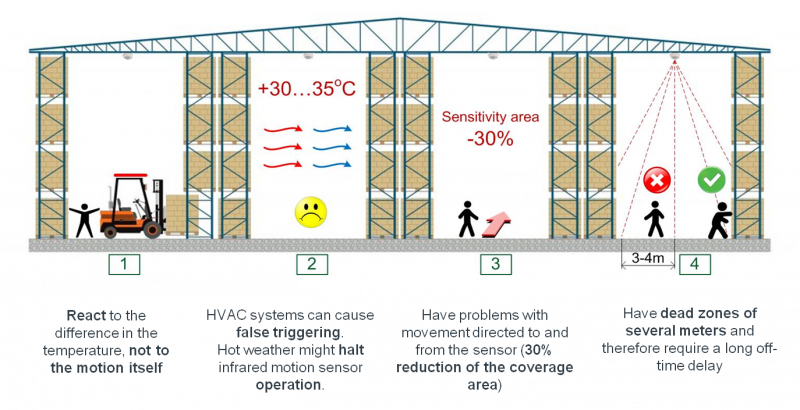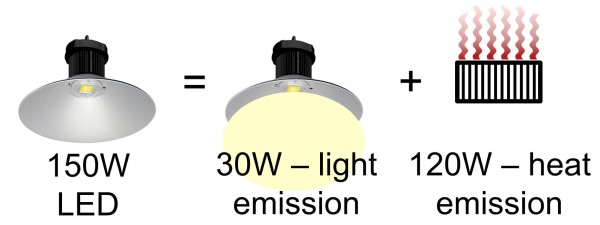- Main
- Applications
- For energy service companies (ESCO)
For energy service companies (ESCO)
Our sensor will reduce the payback time of your project, and you will obtain additional profit compared to other projects performed with the use of PIR motion sensors from any of the world’s leading manufacturers.
If your project is related to lighting system automation, one K2150 sensor will replace 3–4 PIR-sensors in warehouses and 6–8 PIR-sensors in car parks due to its large sensitivity zone.
It will also reduce the length of cable lines and the cost of installation, which can be considerable in warehouses due to the high elevation of the suspension of lights and the need to use special equipment.
 Fig 1. K2150 operation range
Fig 1. K2150 operation range
Thanks to the high sensitivity of the K2150 sensor and the absence of dead zones, it is possible to set a delay of 0.5–1 minutes for switching off lighting instead of 5–10 minutes for PIR-sensors (there is nobody in the control zone and the lighting would still working). This will significantly increase the cost-effectiveness of automation and reduce the payback period of the project. A long delay in switching off the PIR sensors is needed because they are beam sensors and the distance between the control beams is several meters. This is why, for example, for the comfort work of the warehouse personnel, installation companies have to set a long delay in switching off the PIR sensors, which significantly reduces the profile of an energy service company. Our K2150 sensor has very high sensitivity and does not have these disadvantages. For example, it is able to detect a movement of a human palm with an amplitude of 15 cm from a distance of 50–60m. Fig 2. Main disadvantages of infrared motion sensors
You should also know that PIR sensors stop detecting movement when room temperature approaches 30 °C. This is due to the fact that they do not detect movement itself, but the difference in temperature between the ambient environment and a person. For this reason, PIR sensors in warehouses poorly detect electrically powered forklifts if their cab is covered with a polycarbonate roof. So when you calculate the payback of a project in the southern regions of your country or in any of the other warm/ hot climates, you should consider that the automatic PIR sensors will not work for two to four months a year and the lights on the site will be on continuously during this period. We were recently informed by a representative of a well-known Japanese company that has sensors in its Kyoto warehouses that they do not work for about two summer months a year. Our K2150 sensor uses radio wave technology for motion detection and is not influenced by the temperature at the site. The temperature can be within -30°C...+65°C.
The K2150 sensor will allow your company to discover new markets for energy services that were previously unavailable due to a lack of the necessary technologies. It controls the lighting of freezing warehouses (meat, fish, and ice cream) and Fresh class warehouses with high air humidity for storing fruits and vegetables. Our sensor is capable of operating in such conditions and will bring your company even more revenue than in conventional warm warehouses.
This is due to the fact that even the best LED bulbs have only 20% of their energy used to radiate light, and 80% of it is used to produce parasitic heat. That’s why a 150W bulb is not only a light source, but also a continuously operating 120W heater (150W x 0.8 = 120W)! Fig 3. Distribution of the power consumption of an LED bulb for light and heat emission
Thus, in a chilled warehouse without motion sensors, energy is wasted twice: first in heating the air with bulbs, then in cooling it with air conditioners to refrigerate to zero. And this happens 24/7... The K2150 sensor will help reduce these losses by 80%! Today, the lighting in these warehouses is on around the clock.
Now you will be able to implement energy service projects in meat-producing countries such as the USA, Brazil, China, Argentina, Australia, EU, and others.
К2150 sensor's cost effectiveness (using the example of a warehouse)
The object is an actual warehouse with the 72х78 m area, 17 m height, and shelf storage of items. The length of the alleys is 68 m. The forklift drives through the alley every 7 min and stays there for about 1 min. Fig 4. How the traffic intensity in the warehouse affects lighting system automation efficiency
If your project is related to lighting system automation, one K2150 sensor will replace 3–4 PIR-sensors in warehouses and 6–8 PIR-sensors in car parks due to its large sensitivity zone.
It will also reduce the length of cable lines and the cost of installation, which can be considerable in warehouses due to the high elevation of the suspension of lights and the need to use special equipment.

Thanks to the high sensitivity of the K2150 sensor and the absence of dead zones, it is possible to set a delay of 0.5–1 minutes for switching off lighting instead of 5–10 minutes for PIR-sensors (there is nobody in the control zone and the lighting would still working). This will significantly increase the cost-effectiveness of automation and reduce the payback period of the project. A long delay in switching off the PIR sensors is needed because they are beam sensors and the distance between the control beams is several meters. This is why, for example, for the comfort work of the warehouse personnel, installation companies have to set a long delay in switching off the PIR sensors, which significantly reduces the profile of an energy service company. Our K2150 sensor has very high sensitivity and does not have these disadvantages. For example, it is able to detect a movement of a human palm with an amplitude of 15 cm from a distance of 50–60m. Fig 2. Main disadvantages of infrared motion sensors
You should also know that PIR sensors stop detecting movement when room temperature approaches 30 °C. This is due to the fact that they do not detect movement itself, but the difference in temperature between the ambient environment and a person. For this reason, PIR sensors in warehouses poorly detect electrically powered forklifts if their cab is covered with a polycarbonate roof. So when you calculate the payback of a project in the southern regions of your country or in any of the other warm/ hot climates, you should consider that the automatic PIR sensors will not work for two to four months a year and the lights on the site will be on continuously during this period. We were recently informed by a representative of a well-known Japanese company that has sensors in its Kyoto warehouses that they do not work for about two summer months a year. Our K2150 sensor uses radio wave technology for motion detection and is not influenced by the temperature at the site. The temperature can be within -30°C...+65°C.
The K2150 sensor will allow your company to discover new markets for energy services that were previously unavailable due to a lack of the necessary technologies. It controls the lighting of freezing warehouses (meat, fish, and ice cream) and Fresh class warehouses with high air humidity for storing fruits and vegetables. Our sensor is capable of operating in such conditions and will bring your company even more revenue than in conventional warm warehouses.
This is due to the fact that even the best LED bulbs have only 20% of their energy used to radiate light, and 80% of it is used to produce parasitic heat. That’s why a 150W bulb is not only a light source, but also a continuously operating 120W heater (150W x 0.8 = 120W)! Fig 3. Distribution of the power consumption of an LED bulb for light and heat emission
Thus, in a chilled warehouse without motion sensors, energy is wasted twice: first in heating the air with bulbs, then in cooling it with air conditioners to refrigerate to zero. And this happens 24/7... The K2150 sensor will help reduce these losses by 80%! Today, the lighting in these warehouses is on around the clock.
Now you will be able to implement energy service projects in meat-producing countries such as the USA, Brazil, China, Argentina, Australia, EU, and others.
К2150 sensor's cost effectiveness (using the example of a warehouse)
The object is an actual warehouse with the 72х78 m area, 17 m height, and shelf storage of items. The length of the alleys is 68 m. The forklift drives through the alley every 7 min and stays there for about 1 min. Fig 4. How the traffic intensity in the warehouse affects lighting system automation efficiency
150 W LED fixtures without a dimming function, 216 pcs. The number of alleys is 18; the number of fixtures per alley is 12. The lights duty cycle is 24 hours per day.
Energy consumption without automation is 283,824 kWh per year.
Energy consumption with automation (3 emergency fixtures, 9 fixtures that get turned off by the sensor) is 97,567 kWh per year.
Savings: 283,824 - 97,567 = 186,257 kWh per year or 186,257 х 0,15 € = 27,938 € per year.
The modernization cost, including the installation cost, is approximately 24,000 €.
The payback period: 24,000/27,938 = 0.8 years.






